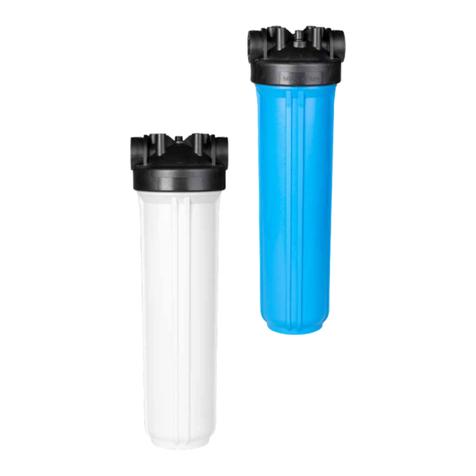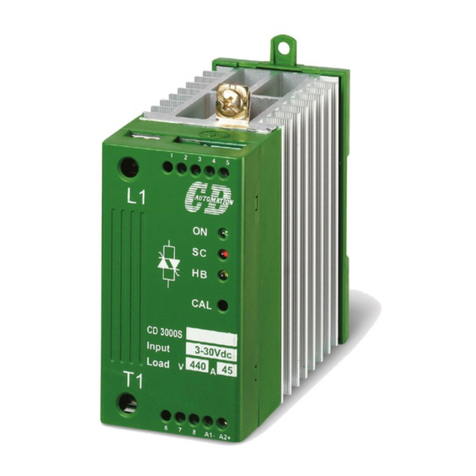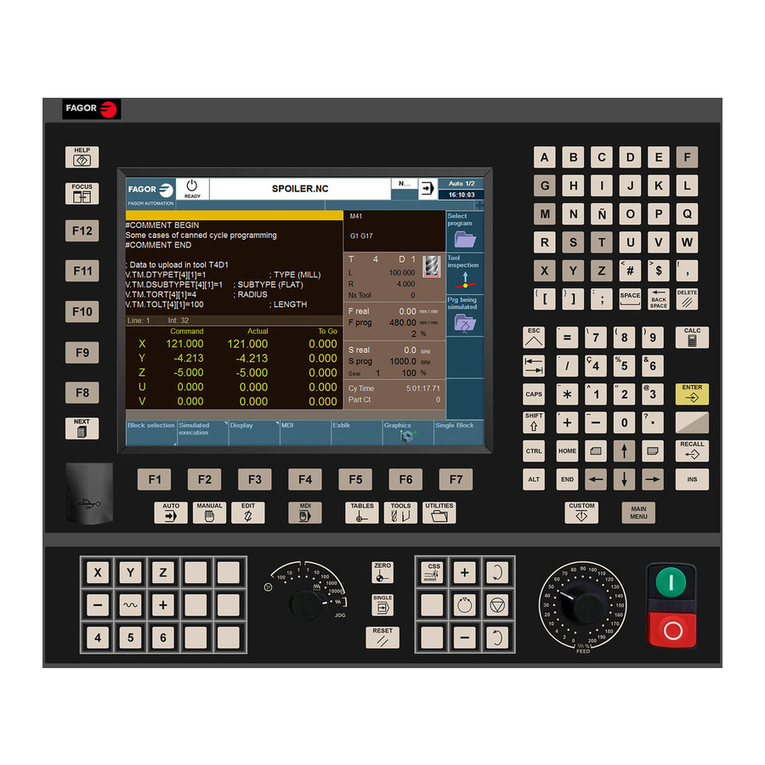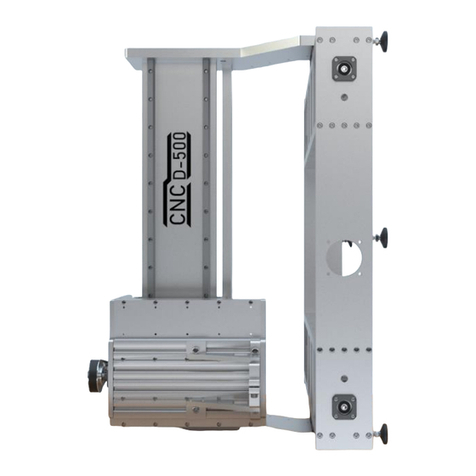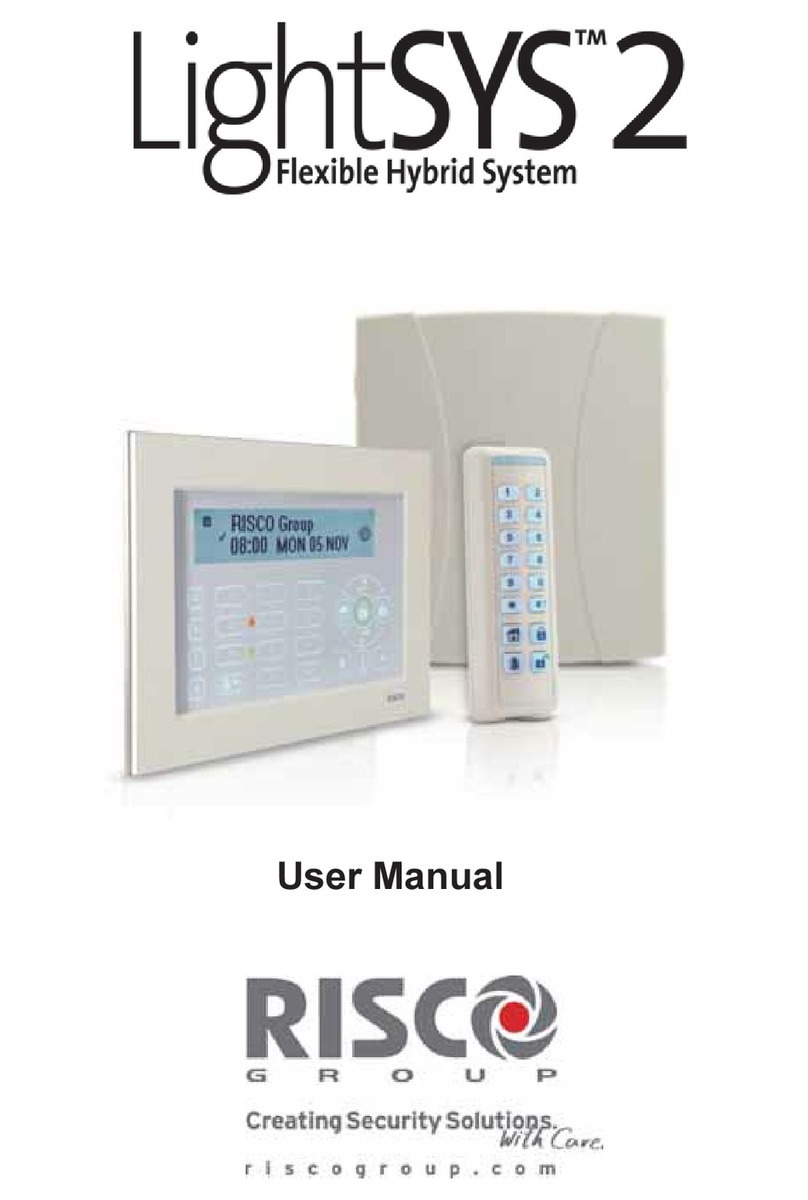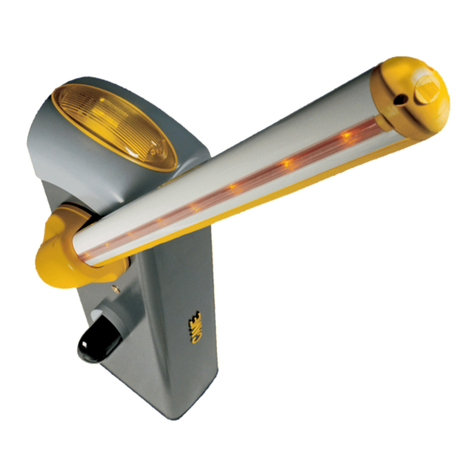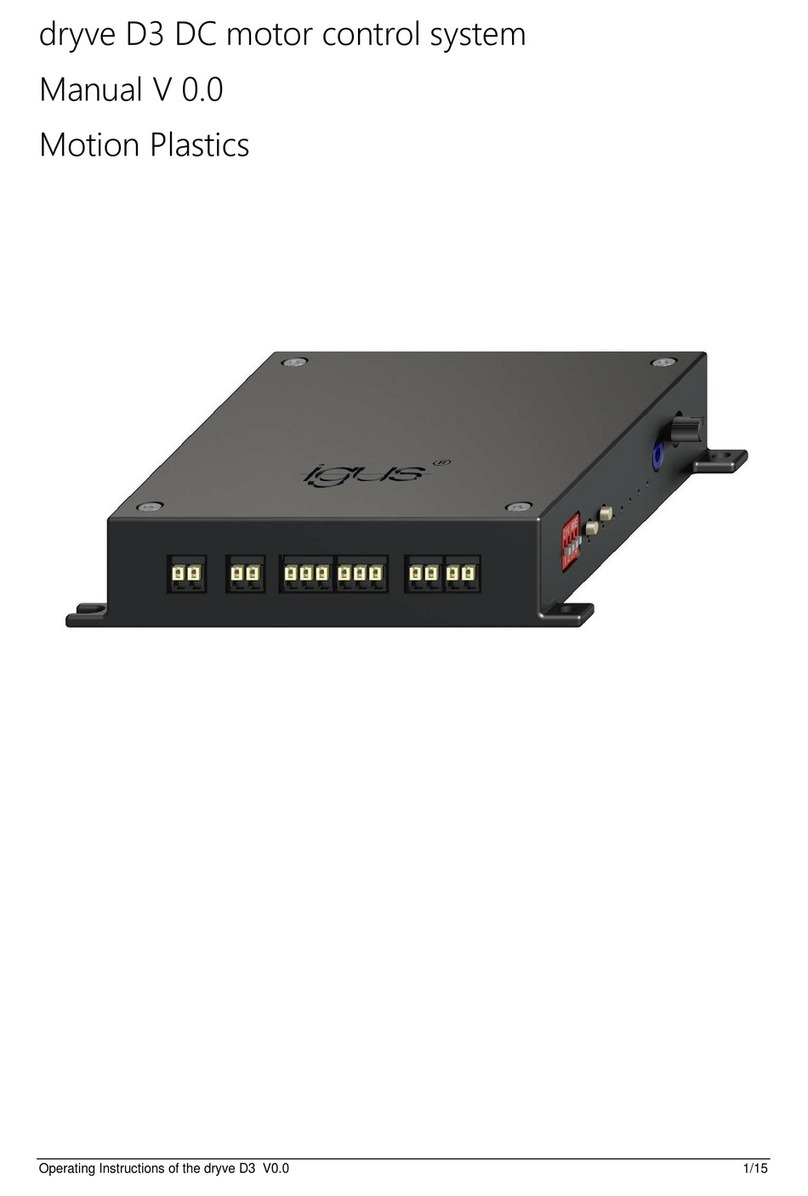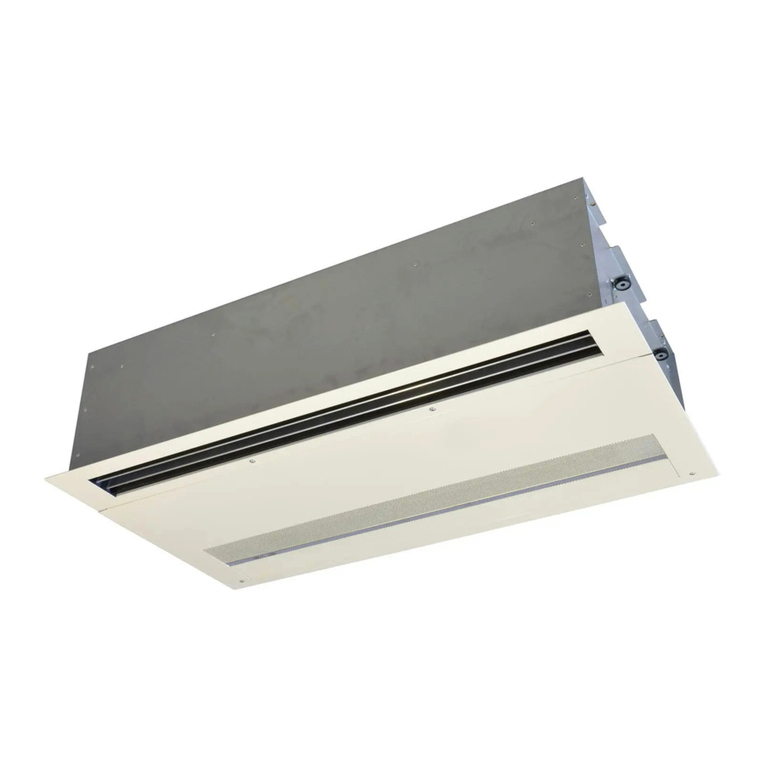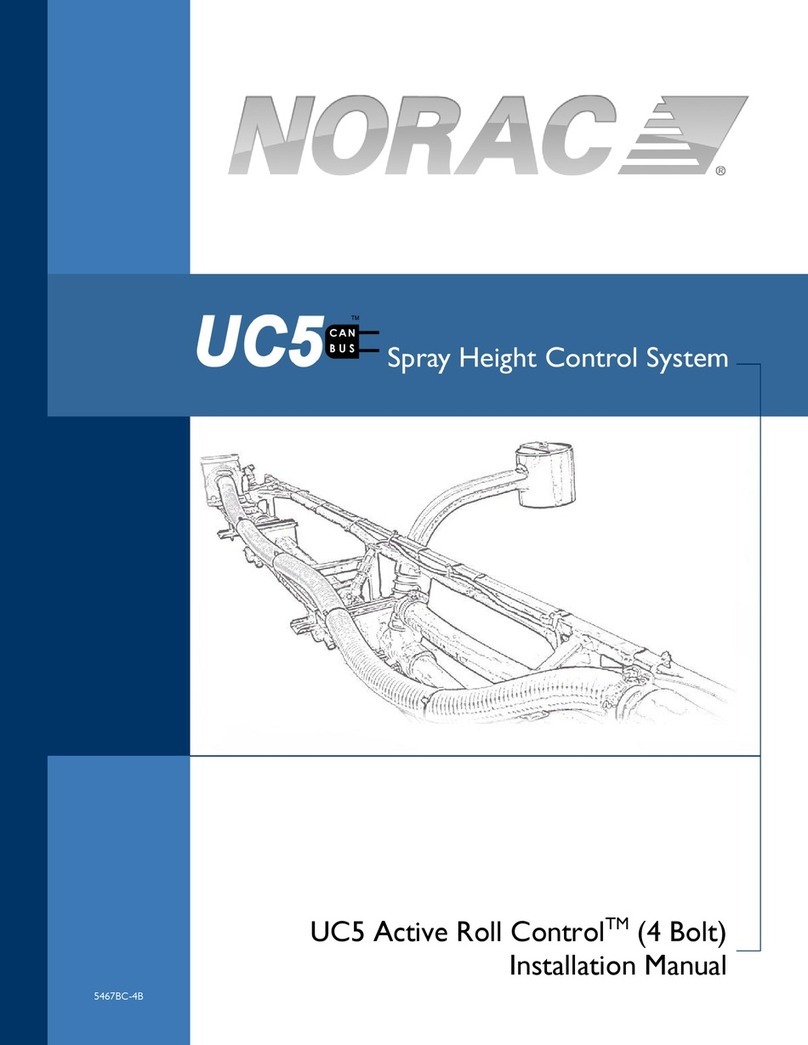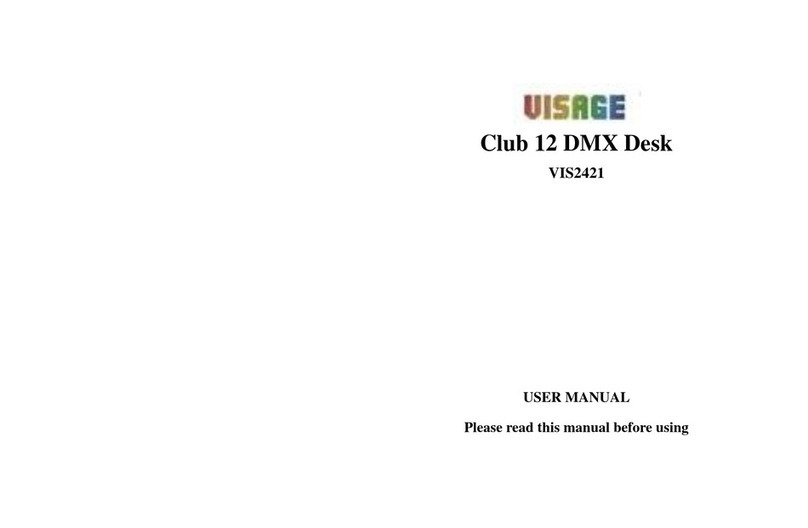Flint & Walling Commander Pro User manual

Flint & Walling © Copyright 2018. All rights reserved.
1
Commander®Pro Variable
Speed Controller System
Instructions
OWNER INFORMATION
System Model Number
Pump Model / Date Code
Pump Serial Number (Silver Label)
Motor Model / Date Code
Motor Serial Number (Silver Label)
Controller Model / Date Code
Dealer
Address
Install Date
TABLE OF CONTENTS
Safety Instructions................................ 2
System Components .............................. 3
Piping & General Information ....................... 3
Controller Location Selection ....................... 4
Controller Installation / Wiring ....................... 5
Start-up Operation................................ 6
System Troubleshooting ........................... 9
024983 F
DESCRIPTIONS AND FEATURES
The Commander®Pro Variable Speed Controller is a
dependable water system Variable Frequency Drive (VFD)
that uses custom programming to enhance the performance
of submersible pumps. When applied correctly to three phase
motor driven pumps, the drive eliminates pressure cycling
associated with conventional pressure switch controlled water
pumping systems and provides a constant output pressure.
Key features of the drive controller include:
• Can use either a pressure switch (no snap action) or
a 4-20mA transducer as the pressure control. At initial
power up, the controller detects whether a switch or
transducer is connected and automatically sets the
control choice.
• Constant water pressure with a wide range of settings
(30-80 psi) (Note: The maximum obtainable system
pressure is limited by the performance of the pump
installed)
• Smaller pressure tank can be used
• Fits the pump to the application – pump speed is
controlled to provide the optimum performance without
overloading the motor
• No in-rush (power-on transient) current
• Low motor start-up current (soft-starting)
• Active Power Factor Correction minimizes input RMS
current
• Protection features
– Dry run conditions – using intelligent load monitoring
(see Page 7)
– Bound pump – with auto-reversing torque
– High voltage / lightning surge
– Low line voltage
– Short circuit
INCLUDED ITEMS:
A. Controller Unit
B. Pressure switch or Transducer
C. Switch or Transducer Cable
D. Installation Manual
E. Small Screwdriver
F. Warranty Card
G. Switch Adjustment Tool (VS Systems only)
HELP LINE: 800-742-5044

Flint & Walling © Copyright 2018. All rights reserved.
2
Follow all local electrical and safety codes as well
as the National Electrical Code (NEC) and the
Occupational Safety and Health Act (OSHA).
The power supply should be a separate circuit,
independent of all other circuits. Be sure it is equipped
with a fuse and disconnect box of ample capacity.
For fire protection, the power supply should be
free of any building, preferably on a direct line
from the transformer. In the event of fire, the
wires will not be destroyed and the water supply
not cut-off.
Always disconnect power source before
performing any work on or near the motor or its
connected load. If the power disconnect point is
out-of-sight, lock it in the open position and tag it
to prevent unexpected application of power. Failure to do
so could result in fatal electrical shock.
DO NOT handle pump with wet hands or when
standing in water as fatal electrical shock could
occur. Disconnect main power supply before
handling pump for any reason.
Shut off power source when voltage drops below 210 on
230 volt installations.
Protect the power cable from coming in contact with
sharp objects, oil, grease, hot surfaces or chemicals.
DO NOT kink the power cable. If damaged replace
immediately.
NEVER leave the control box, fused disconnect switch,
or covers open (either partially or completely) when not
being worked on by a competent electrician or repairman.
Always use caution when operating electrical
controls in damp areas. If possible, avoid all
contact with electrical equipment during
thunderstorms or extreme damp conditions.
Install all electrical equipment in protected area to
prevent mechanical damage which could produce serious
electrical shock and/or equipment failure.
Pump is designed to pump cold ground water that is
free of air or gases. Decreased pump performance and
life expectancy can occur if the ground water is not cold
(86ºF/30ºC) or contains air or gases.
Pump and controls must be securely and
adequately grounded as specified in section 250-
43 item (A) of the U.S.A. National Electric Code
(NEC) and Section 26-954 Canadian Electrical
Code. Failure to do so could result in a fatal injury.
DO NOT use this pump to pump flammable liquids such
as gasoline, fuel oil, kerosene, etc. Failure to follow the
above warning could result in property damage and/or
personal injury.
The pump is intended for use in a well. Motor
frame must be connected to power supply ground
or fatal electrical shock may result. Do not use
this pump in swimming pools.
Capacitors inside the drive controller can still hold
a lethal voltage even after power has been
removed. Allow 10 minutes for dangerous internal
voltage to discharge before making changes to
input power or motor connections.
Do not use motor or system in swimming areas.
IMPORTANT SAFETY INSTRUCTIONS
Rules for safe installation and operation.
Read these warnings and instructions carefully. Failure to follow them could cause serious bodily injury and/or property
damage.
Do not use power factor correction capacitors with the
drive controller. Damage will result to both motor and
drive.
This equipment should be installed by technically
qualified personnel. Failure to install it in compliance
with national and local electrical codes and within stated
recommendations may result in electrical shock hazard,
fire hazard, unsatisfactory performance, or equipment
failure.
NOTE: Units with the "ETL/CUS" mark are tested to UL
standard UL508C & CSA standard C22.2 No. 274.

Flint & Walling © Copyright 2018. All rights reserved.
3
SYSTEM COMPONENTS
Please be sure that you have all major system components
necessary to properly install the submersible pump system.
Other components may also be necessary depending on the
application requirements.
1. Submersible pump end
2. Submersible motor
3. Variable speed controller
4. Pressure tank
5. Pressure switch or transducer (packaged with controller)
6. Pressure relief valve (purchased separately)
7. Pressure gauge (purchased separately)
PIPING
General Information
The system is capable of flows up to 40 GPM. Discharge
piping is recommended to be 1.25” for installations in which
flows will exceed 12 GPM. The use of smaller pipe will
increase friction losses and can severely limit the maximum
capacity of the system.
This pump may be capable of pressures exceeding 325 PSI
under maximum conditions, select pipe accordingly. Consult
your pipe supplier to determine the best pipe material for the
installation
Pump Inspection
Prior to installation check the pump, motor, controller and tank
for shipment damage.
Pressure Tank
The Air-E-Tainer® tank supplied with your system has a
factory set pre-charge of 35 PSI. Installer must recheck to
make sure tank is still 35 PSI. This is 70% of the factory
preset operating pressure of 50 PSI. Any change in operating
system pressure will require that the pre charge in the tank
be modified to 70% of that pressure. See Tank Table for
minimum pressure tank size.
MINIMUM PRESSURE TANK SIZE (TOTAL
CAPACITY)
Controller
Pump Flow
Rating less
than 12 GPM
Pump Flow
Rating 12 GPM or
higher
VS15/TVS15 4.6 Gal (132477) 4.6 Gal (132477)
VS20/TVS20 4.6 Gal (132477) 14 Gal (132661)
VS30/TVS30 14 Gal (132661) 14 Gal (132661)
TVS50 14 Gal (132661) 20 Gal (132662)
Many pumps can develop excessive
pressure, resulting in equipment and property damage
as well as possible injury. Always install a pressure relief
valve capable of passing full pump flow at 100 PSI. Install
the pressure relief valve between the pump and pressure
tank.
PRESSURE SETTING GUIDE
System Pressure
(at Pressure Sensor)
Pressure Tank Setting
(PSI) (+/- 2 psi)
25 18
30 21
35 25
40 28
45 32
50 (factory set) 35
55 39
60 42
65 46
70 49
75 53
80 56
Pressure Relief Valve
The pressure relief valve and the discharge outlet need a
flow rating which exceeds the flow capacity of the installation
at the relief pressure. When located in an area where a water
leak or relief valve blow-off may damage property connect
an adequate drain line to the pressure relief valve. Run the
line to a suitable drain or to an area where the water will not
damage property.
Not providing an adequate relief valve
can cause extreme overpressure which could result in
personal and/or property damage. It is recommended
that you manually activate the valve monthly to keep it in
good working order.
Discharge Pipe
When discharge piping requires an adapter it is
recommended that a stainless steel adapter be used.
Galvanized fittings or pipe should not be connected directly
to the stainless steel discharge head of the pump as galvanic
corrosion may occur. Barb type connectors should always
be double clamped. Torque arrestors are not required on this
installation due to the soft starting characteristics of the motor
and controller
Check Valve
A check valve is factory installed in the discharge head of the
submersible pump. This maintains water within the pipe when
the pump is not operating. For well depths exceeding 100
feet, an additional check valve should be installed every 100
feet.
Safety Rope
A safety rope eyelet is provided at the discharge of the pump.
It is recommended to attach a nylon safety rope. This will
assist in the removal of the pump and also prevent loss of
the unit in the bottom of the well due to a loose fitting or pipe
deterioration.

Flint & Walling © Copyright 2018. All rights reserved.
4
CONTROLLER LOCATION SELECTION
The NEMA 3R controller is intended for indoor and outdoor
use and for operation in ambient temperatures up to 125°
F (50° C). It should be mounted in a location that provides
protection from water sprays greater than 30° from vertical.
The drive should only be accessed by trained and authorized
personnel. To ensure maximum weather protection, the
unit must be mounted vertically with the cover properly
aligned and secured with all lid screws. The following
recommendations will help in selection of the proper location
of the unit:
1. A tank tee is recommended for mounting the tank,
pressure switch/transducer, pressure gauge, and
pressure relief valve at one junction. If a tank tee is not
used, the pressure switch/transducer should be located
within 6 ft. (1.8 meters) of the pressure tank to minimize
pressure fluctuations. There should be no elbows
between the tank and pressure switch/transducer.
2. The unit should be mounted on a sturdy supporting
structure such as a wall or supporting post - please
account for the fact that the unit weighs approximately 20
lbs.
3. The electronics inside the controller are air-cooled. As a
result, there should be at least 6 inches of clearance on
each side and below the unit to allow room for air flow.
IL1721
Commander®Pro
VariableSpeed
Controller
®
FW1629A
COMMANDER® PRO
Variable Frequency Drive
www.getcommanderpro.com
FW1629B
6.8366
2.7963
Notesdo not print
Pressure
Tank Pressure
Switch or
Transducer
Pump
Motor
Pressure
Relief Valve
Figure 2 Location Diagram
There should be at least 6 inches of
clearance on each side and below the unit to allow room
for proper air flow. There are to be no elbows between
the tank and pressure switch.
4. The controller should only be mounted with the wiring
end oriented downward. If possible for best cooling,
the controller should not be placed in direct sunlight
or other locations subject to extreme temperatures or
humidity (mounting location should not be subjected to
condensation).
5. The mounting location should have access to 230V
electrical supply and to the submersible motor wiring.
6. Do not expose the drive to water spray greater than 30°
from vertical.
Note: Installations that require larger than 6 AWG wire will
require an external junction box. Run 6 AWG from the drive
to the junction box and make external connections to the
appropriately sized wire with wire nuts.
WIRING SIZING CHART
Maximum Wire Lengths Connecting the Controller
to The Main Circuit Box
(Based On 3% Voltage Drop At 230V)
Motor
HP
Copper
Wire
Size
(AWG) 14 12 10 8 6 4 3 2
Circuit
Breaker
1.5/2 Max.
Length.
(Ft.)
85* 140* 220 345 550 680 895 20 AMP
3 115* 180 285 455 560 740 25 AMP
5115 185 290 360 470 40 AMP
* Wire with 90°C Insulation only
PUMP WIRING
If submersible pump type is chosen, the output of the drive is
3-phase. (If the option is available, 3-wire may be available
for submersible pumps).
The power output terminals (for motor wire connections) are
located on the lower right-hand side of the controller and are
labeled RED, BLK, YEL and (W). To select the wire size refer
to the pump owner’s manual, NEC and local codes for proper
wire size.
NOTICE: Regardless of owner’s manual, wire length should
not exceed 1000 ft.
If the Commander Pro Controller is used with above ground
motors the output is limited to 3-phase. To maximize motor
life the cable length between the controller and the motor
should be limited to a maximum length of 25 ft. Refer to the
pump owner’s manual, NEC and local codes for proper wire
size. Caution: Correct motor rotating needs to be verified to
avoid pump and motor damage.
Due to the inherent voltage changing
characteristics of variable frequency drives (VFD), there
is additional stress placed on the insulation of the wire
between the controller and the motor compared to a
standard pump system. Extra care must be taken when
using Un-jacketed Flat Parallel Pump Cable to ensure that
the insulation on each of the separated wires is the same
thickness. Care must also be taken to ensure a proper
seal with shrink tubing on any splices. Failure to take
these precautions can lead to “wire burn through” that
will shut down the system. Under these circumstances,
no permanent damage usually occurs to the controller or
motor. For further details call Technical Support at
800-742-5044.
SEPARATED WIRE

Flint & Walling © Copyright 2018. All rights reserved.
5
Figure 3 Wire Illustration
NOTE: DO NOT USE ALUMINUM WIRE.
Attention: To meet full compliance with FCC Part 15
Subpart B and CENELEC EN 55011, shielded motor
cable should be used between the drive motor output and
the motor. Using shielded cable provides the maximum
filtering to reduce radiated & conductive emissions which
can cause interference with other devices.
CONTROLLER INSTALLATION PROCEDURE
1. Disconnect electrical power at the main breaker
2. Drain the system (if applicable)
3. Install pressure switch or transducer - the pressure switch
or transducer has a 1/4 - 18 National Pipe Thread (NPT)
connection.
4. Remove the controller cover by removing the lid screws.
Attach the unit to the wall using mounting screws (not
included).
Wiring Connections
1. Verify that the power has been shut off at the main
breaker.
2. Verify that the dedicated branch circuit for the controller is
equipped with the correct rating of circuit breaker.
3. Remove the controller lid.
L1 L2
IN OUT + - S1 S2
ALARMS FAN SENSOR
IL1791
RED
BLK
YEL
Feed motor and ground leads
through appropriate knockout
and connect to RED, BLK, YEL
and Won right hand terminal
block.
Figure 4
4. Feed the motor and ground leads thought the appropriate
knockout on the bottom right side of the unit and connect
them to the terminal block positions. Submersible
3-Phase or 3-Wire 1-Ph motors: follow colors as marked:
Red (RED), Black (BLK), Yellow (YEL) and (W).
Submersible 3-Phase or 3-Wire 1-Ph motors: follow
colors as marked: Red to RED, Black to BLK, Yellow
(YEL) and Green Ground wire (W). Submersible 2-Wire
1-Ph motors: Connect motor leads to BLK, YEL and
Green Ground wire (W).
Above Ground Motor (3-Phase Only): L1 to RED,
L2 to BLK, L3 to YEL and Green Ground wire (W)
Verify motor rotation to avoid damage
to pump & motor.
L1 L2 RED BLK YEL
IN OUT + - S1 S2
ALARMS FAN SENSOR
IL1790
Feed 230V power and ground
leads through appropriate
knockout and connect to
L1, L2 and Won left hand
terminal block
Figure 5
5. Feed the 230V power and ground leads through the
appropriate opening on the bottom left side of the
controller and connect them to the terminals marked L1,
L2 and W.
S2
IL1792
S1
Feed the pressure
switch/transducer
wire through the strain
relief (bottom right) and
route cable through
grommeted hole above
the motor power terminal
block.
Connect to S1 and S2
terminals on display board
terminal strip.
For transducer,
Brown wire connects to S1
Blue wire connects to S2
Grommeted hole
IN OUT + -
ALARMS FAN SENSOR
Figure 6
6. Install provided strain relief in the smaller hole on the
bottom right hand side of the controller unit. Feed the
pressure switch or transducer leads through the strain
relief and route the leads through the grommetted hole
above the motor terminals.
- For Switch (VS Drive Kit): Connect the red and black
lead wires to the terminals marked "S1" and "S2"
(interchangeable) on the display board terminal strip with
a small screwdriver (provided).
- For Transducer (TVS Drive Kit): Connect the Brown wire
to the terminal marked "S1" the Blue Wire to terminal

Flint & Walling © Copyright 2018. All rights reserved.
6
"S2" on the display board terminal strip with a small
screwdriver (provided).
Tighten the strain relief on the pressure switch/transducer
lead.
IL0026
Remove rubber end cap
to adjust pressure. Use
7/32” allen wrench
Pressure switch
boot
Figure 7 Pressure Switch
IL1875
Figure 8 Pressure Transducer
A 10 foot section of cable is provided with the system
to connect to the pressure switch / transducer. Lengths
of up to 100 feet can be used, provided the appropriate
shielded cabling is used. Consult the factory for proper
cable specification.
7. Use the appropriate strain relief or conduit connectors
(not included).
8. Replace the cover. Do not over-tighten the screws.
9. Set the pressure tank pre-charge to 70% of the desired
water pressure setting. To check the tank’s pre-charge,
de-pressurize the water system by opening a tap.
Measure the tank pre-charge with a pressure gauge at its
inflation valve and make the necessary adjustments.
NOTE: For pressure switch installation (VS systems) only,
Follow steps 10, 11 & 12. (Figure 7)
For pressure transducer installations, skip to Step 13.
10. Connect the other end of the pressure switch cable with
the two spade terminals to the pressure switch. The
connections are interchangeable.
11. The pressure switch communicates the system pressure
to the controller. The switch is preset at the factory to
50 psi, but can be adjusted by the installer using the
following procedure:
a. Remove the rubber end-cap.
b. Using a 7/32” Allen wrench (provided), turn the
adjusting screw clockwise to increase pressure
and counter-clockwise to decrease pressure. The
adjustment range is between 30 and 80 psi (1/4 turn =
approximately 3 psi).
c. Replace the rubber end cap.
d. Reset the pressure tank pre-charge to the appropriate
pressure
12. Cover the pressure switch terminals with the rubber boot
provided.
For pressure transducer installation (TVS systems) only,
Follow Step 13. (Figure 8):
13. Connect the free end of the transducer cable to the
transducer by lining up the keyway on the connector
to the transducer, pressing the cable into place & then
tightening the thumbscrew finger tight.
START-UP OPERATION
Apply power to the controller. The display should briefly show
“Please Wait Initializing” and then read “Press Enter to Begin
Set-Up”. Pressing ENTER button will begin taking you through
the quick set-up menu where you can select Pump type
(Submersible or Above Ground); Motor type (Three Phase,
3W Single Phase - if option is available); Maximum Motor
Current; Maximum Frequency; Control (Switch, Transducer)
by using the UP & DOWN buttons to change the setting
and then pressing the ENTER button to save the choice.
Once all the choices have been selected, press the STOP/
START button to save the setting to the controller’s memory.
The drive will then spin the motor in a reverse direction for
a couple of seconds and then begin to run the motor in the
correct direction and begin regulating the pressure. While the
drive is running the motor, for VS drive kits (pressure switch)
the display will show the current that the motor is drawing and
the frequency that is being supplied. When there is no water
use, the controller will shut off the output to the motor and the
display will show “Motor is in Standby Mode”. For TVS drive
kits (transducer) the display will show the transducer pressure
reading, current that the motor is drawing and the frequency
that is being supplied.
NOTE: Conventional private water systems intermittently fill a
pressure tank as commanded by a standard pressure switch
(e.g. 30 - 50 psi). The constant pressure controller maintains
a constant pressure at the pressure switch/transducer up to
the maximum capability of the motor and pump. Although the
pressure is constant at the pressure switch or transducer,
pressure drops may be noticeable in other areas of the home
when additional taps are opened. This is due to limitations in
the plumbing and will be more pronounced the further the taps
are from the pressure switch/transducer. This would be true of
any system, and if observed, should not be interpreted as a
failure in the performance of the constant pressure controller.
Serious or fatal electrical shock may
result from contact with internal electrical components.
DO NOT, under any circumstances, attempt to modify
connections to the drive until power has been removed
and 10 minutes have passed for internal voltages to
discharge!

Flint & Walling © Copyright 2018. All rights reserved.
7
Underload Sensitivity
The controller is configured at the factory to ensure detection
of Underload faults in a wide variety of pumping applications
including dead head and run dry conditions. In very rare
cases (as with certain pumps in shallow wells) this trip level
may result in nuisance faults. If the pump is installed in a
shallow well, activate the controller and observe system
behavior. Once the controller begins to regulate pressure,
check operation at several flow rates to make sure the default
sensitivity does not induce nuisance Underload trips. If it
becomes necessary to desensitize the Underload trip level,
please call of Technical Support at 800-742-5044 for further
details.
UNDERLOAD INTELLIGENT RESET
(Display shows Dry Well Trip)
If a motor Underload fault condition occurs, the most likely
cause is an over-pumped well (dry well) or loss of incoming
feed water to the pump. In a dry well situation to allow
the well to recover, the controller will wait 30 seconds to 5
minutes, determined by the amount of time the motor had
been running before sensing the dry well, before restarting
the motor. For example, the first time the fault occurs and
the pump has been running 6 minutes, the controller stop the
motor and will wait 30 seconds before attempting to restart
the pump. If the system would then run for 2 minutes and an
dry well fault recurs, the controller will wait 3 minutes before
attempting to restart the pump. This schedule allows for the
minimum off-time possible based on the recovery time of the
well.
If there is an obstruction (such as a closed valve) between
the pump and the pressure switch/transducer, the controller
will also sense an underload deadhead condition stopping the
motor to avoid damaging the pump.
0
1
2
3
4
5
6
0 1 2 3 4 5 6 7 8
IL1448
Run T ime (Minut es)
O Time (Minutes)
“Intelligent Reset” Recovery Time
Over Temperature Protection
The controller is designed for full power operation in ambient
temperatures to up to 125°F (50°C) as long as the input
voltage is at 230V. Under severe thermal situations, the
controller will reduce power output by reducing the output
frequency in order to avoid shutting down. Full speed output
is restored when the temperature cools.
External alarm trip terminals
The control is fitted with an Alarm In terminal block on the
display board. Using these terminals, an external control
switch can be wired to the drive. With this connection, an
external control such as an over pressure, under pressure,
timer, low level switch, etc. can be used to trip the drive with
an “External Fault” trip. For this connection to work properly,
the Alarm in Relay contact condition setting in the Advanced
Features Menu must be set to match the switch position
to activate the drive. (Example: An irrigation timer closes a
contact to single the drive to run, the Alarm In Relay setting
should be set to NC (Normal Closed) for the drive to be active
during the irrigation cycle.)
This connection can also be used with the “External Control”
feature in the advanced options menu to put the drive in
standby rather than causing an external fault trip.
Caution: The external control must be a dry contact
(i.e. no voltage applied to the Alarm In terminals of the
controller) to not damage the drive circuit boards. An
external control with voltage can only be used with the
controller if an isolation relay is used in conjunction with
the voltage source. Contact technical support for more
information.
Leaky Systems (Pressure Switch Control)
Leaky water systems might keep the controller running due
to the accurate pressure sensing capability of the pressure
switch. Continuous running or starts and stops do not hurt
the controller, pump or motor. However, to reduce the on-time
of the controller/pump/motor, a “Bump-Mode” has been
programmed into the drive. During very low flow (or leaky)
conditions this feature periodically increases the speed of the
pump several PSI above the set point and shuts off the pump.
This adds some time to bleed off before the system starts
up again. This “Bump-Mode” can be turned off or adjusted if
desired. Please call Technical Support at 800-742-5044 for
further details.
Fill Pipe Mode (Transducer Control)
At initial power up, the drive is automatically in the Fill Pipe
Mode for 3 minutes. This allows a new installed system to
fill the pip and build up pressure without having the pump
trip out because it is sensing low pressure. If additional time
is needed, this mode can be turned back on and the time
increased in Parameter menu #7.
Use of Engine Drive Generators
There are several technical issues that go into correct sizing
of a generator for use with a VFD controller. Since the VFD
is a “non-linear load”, the generator needs to be oversized
considerably for proper operation. Listed below is minimum
recommended sizing of a generator for each drive rating if the
VFD controller is the only load on the generator. Because of
the variation in design of voltage controls used in generators,
the generator manufacture should always be contacted to
verify the correct sizing when used with a VFD controller.
For best results when used with a generator in the Advanced
Features Menu the Powered by Generator option needs to
be set to “Yes”.

Flint & Walling © Copyright 2018. All rights reserved.
8
VFD Minimum Generator rating
VS/TVS15 4.8kW
VS/TVS20 8.0kW
VS/TVS30 10.0kW
TVS50 15.7 KW
Note: If additional loads are being supplied by the generator,
the generator manufacture should be contacted for correct
sizing. When the controller is being supplied power by a
generator the Powered by Generator option should be set
to YES in the advanced features menu to minimize possible
damage to the drive.
Drive Configuration
When sized correctly, the drive controller package systems
are fully programmed and are ready to go right out of the box
without need for additional configuration. There are several
parameters that can be changed:
Figure 9 Display and Keypad
Capacitors inside the drive controller
can still hold a lethal voltage even after power has been
removed. Allow 10 minutes for dangerous internal voltage
to discharge before making changes to input power or
motor connections.
By pressing and holding the EDIT & ENTER buttons down
together for 5 seconds, you enter into the program menu.
Using the UP & DOWN buttons, you can scroll through the
menus and view the current settings. To make a change to
a parameter press the EDIT button followed by the UP and
DOWN buttons to set or choose the new value. Once the
new values is set, press the ENTER button to accept the new
value or the ESCAPE button to discard the change. Once
you are done viewing and changing the parameters press
ESCAPE to return to the home screen.
For further information to change these parameters, please
call Technical Support at 800-742-5044.
KEY:
APPLIES ONLY TO TRANSDUCER
APPLIES ONLY TO PRESSURE SWITCH
APPLIES TO EITHER OPTION
(1) Control Choice Switch or Transducer At initial power-up, the drive will detect what control devise is
attached and will automatically set the control choice. If a switch or
transducer is not hooked up, the drive will default to Switch as it's
control choice.
Set Transducer Range
(Only for Transducer
Control)
50-300 PSI
Default 100 PSI
Programs the drive to the range of the pressure transducer that is
attached. (Drive ships with 100PSI transducer.)
Set Pressure Set Point
(Only for Transducer
Control)
15 - (Max Transducer range - 5)
Default 50
Target system pressure.
Set Draw Down PSI
(Only for Transducer
Control)
2-15 PSI
Default 5 PSI
Sets the amount that the system pressure has to drop below the set
point while the drive is in standby before the drive will restart the
motor.
Access menu options by pressing and holding edit and enter for 3 seconds.
Menu Option Action Notes

Flint & Walling © Copyright 2018. All rights reserved.
9
(2) Maximum motor current Set Max Motor Amps.
Default 1.5Hp Drive = 5.9 A
Default 2.0Hp Drive = 8.1 A
Default 3.0Hp Drive = 10.9 A
Protects the pump motor assembly from operating beyond its
maximum capability.
(3) Maximum frequency Options 60, 70, 80 Hz.
Default 80 Hz.
Setting frequency determines the maximum motor speed. For
matched HP rating of motor & pump end, set to 60 Hz. For pump
end of half the HP rating of the motor (i.e. 3/4HP pump & 1.5 HP
motor), set to 80 Hz.
(4) Pass code enable (Y/N) Sets 5 digit pass code using Up/
Down keys.
Default No.
Pass code restricts parameters being changed by non-authorized
individuals. If pass code lost, Call 1-800-345-9422 for assistance.
(5) Underload protection (On, Off, Prime) Turns underload
protection on, off, or off for 30 minutes.
Default ON.
Recommend that this is left On. Provides pump protection from
deadhead or dry well conditions. May need to be Off/Prime when
priming a centrifugal or if filling irrigation system.
Set Deadhead trip point: Default 1.5Hp Drive = 5.0 A
Default 2.0Hp Drive = 6.4 A
Default 3.0Hp Drive = 8.2 A
If the motor current falls below this set point when drive has ramped
to maximum frequency, the drive will trip on Deadhead Fault. Adjust
down in increments of .2 if experiencing nuisance deadhead trip.
Set Dry well trip point: Default 1.5Hp Drive = 3.9 A
Default 2.0Hp Drive = 5.3 A
Default 3.0Hp Drive = 6.5 A
If the motor current falls below this set point when drive has ramped
to maximum frequency, the drive will trip on Dry Well Fault. Adjust
down in increments of .2 if experiencing nuisance dry well trip.
Set Dry well off time: Off, 15 to 240 Min, 12 Hrs, or 24 Hrs.
Default Off.
If set to "Off", dry well time is variable by Intelligent reset. This can be
set to fixed time off before restarting in a range of 15 to 240 minutes
in increments of 15 minutes, or 12 or 24 hours if desired.
(6) Bump mode
(Switch Control Mode)
(On, Off) Leak detection.
Default On.
Turns On or Off a small pressure boost if the drive detects a very
low load (leak condition). This will reduce the run time of the
pump and drive.
Set bump mode
frequency:
Sets bump mode threshold frequency.
Default 45 Hz.
When the drive is running for 15 seconds below this frequency.
and current is below the BM current, the drive will ramp up
for the BM duration regardless of switch state to create an
overpressure drawdown.
Set bump mode duration: Sets the time duration of the ramp up
for a bump in PSI (.5 to 2.0 sec.)
Default 0.5 sec.
By increasing this duration time, the amount of overpressure
for drawdown can be increased. Caution: Increasing this time
too much has the potential of creating a high over pressure
condition.
Set bump mode current: Sets bump mode threshold detection
current.
Default 1.5Hp Drive = 3.1 A
Default 2.0Hp Drive = 4.7 A
Default 3.0Hp Drive = 6.1 A
When the drive is running for 15 seconds below this current and
the frequency is below the BM frequency, the drive will ramp
up for the BM duration regardless of switch state to create an
overpressure drawdown.
(6) Standby Sensitivity
(Transducer Control Mode)
Parameters for allowing the drive go into
standby mode at no/low flow.
Set Standby frequency: Sets Standby threshold frequency.
Default 45 Hz.
When the drive is running for 15 seconds below this frequency. and
current is below the standby current, the drive will begin ramping the
motor speed down and monitor system pressure to go into standby
mode.
Set Standby Drawdown: Sets the amount the system pressure
can fluctuate after low load is sensed
and still go into standby mode(.5 to 2.0
PSI)
Default 0.5 PSI
By increasing this duration time, the amount of overpressure for
drawdown can be increased. Caution: Increasing this time too much
has the potential of creating a high over pressure condition.
Set Standby current: Sets Standby threshold detection
current.
Default 1.5Hp Drive = 3.1 A
Default 2.0Hp Drive = 4.7 A
Default 3.0Hp Drive = 6.1 A
When the drive is running for 15 seconds below this current and
frequency is below the standby current, the drive will begin ramping
the motor speed down and monitor system pressure to go into
standby mode.
Set Standby rate: Sets Standby deceleration rate (5-35)
Default 15.
This is the rate that the drive begins slowing down the motor to enter
standby mode.
(7) Broken pipe mode (On/Off).
Default ON.
Turn On/Off broken pipe trip. When On, if the drive is running the
PMA continuously for the set time period, the drive will trip out on
"Broken Pipe".
Set broken pipe run time: (1, 8, 16, 24, 48) Hours
Default 24 Hours.
Define the time that the drive can run continuously before tripping on
Broke Pipe.
Access menu options by pressing and holding edit and enter for 3 seconds.
Menu Option Action Notes

Flint & Walling © Copyright 2018. All rights reserved.
10
(8) Advanced features
Drive parameters View the current output Hz, Amps & heat
sink temperature.
Used for diagnostic purposes in troubleshooting overheating drive.
Motor Type (Submersible/Above Ground) Change
setting for the type of pump motor
This option in used to change the setting for the type of pump motor
the control was set to use during the initial set-up menu.
Manual run pump mode (Off/On) Sets pump to run without
pressure switch.
Default OFF
Turn on a manual run condition at a set frequency for a defined
amount of time.
Set manual pump
frequency:
(50, 60, 70, 80 Hz)
Default 60 Hz.
Set the constant frequency (motor speed) of the Pump. (only required
if manual mode ON)
Set manual pump run time: (1/2, 1, 4, 8, 16, 24, 48, Cont.) - Hours)
Default 24 Hours.
Sets the time that the drive will run before shutting itself off. If set
for Cont. (typically not recommended), the drive will run continuously
until it is stopped manually. Broken pipe mode is not active when
manual run is on. (only required if manual mode ON)
External control mode (Off/On).
Default OFF.
Determines if the Alarm In contacts trips out the drive or just puts it in
Standby Mode. If Off and the contacts wired to the Alarm In terminal
blocks are inverse of the Alarm in Rely settings, the drive trips out on
External Trip. (Used for protection like over pressure.) If On and the
contacts wired to the Alarm In terminal blocks close, the drive goes to
Standby Mode. (Used for control like a timer contact for an irrigation
system.)
Alarm In Relay (NO/NC) Sets alarm in contact settings.
Default NO.
If set to normally Open, drive will operate normally when the contacts
are open & trip (or go to standby mode) when contacts close.
(Example: An irrigation timer closes a contact to single the drive to
run, the Alarm In Relay setting should be set to NC (Normal Closed)
for the drive to be active during the irrigation cycle.)
Drive status relay (NO/NC) Sets alarm out relay as
normally open or normally closed.
Default NO.
The state of the relay changes when the drive trips. Typically not for
use in most residential applications.
Powered by Generator (No/Yes)
Default No.
Set the drive circuitry to expect power delivered from a gas driven
generator. Depending upon application a 5-10% pressure drop of can
be experienced when the drive is running the pump & motor at full
speed.
Ramp up sensitivity
(Switch Control Mode)
(1, 2, 3, 4, 5) Sets Ramp Up speeds.
Default 2.
If excessive pressure fluctuations on pressure gage is noticed, the
ramp rates can be adjusted.
Ramp down sensitivity
(Switch Control Mode)
(1, 2, 3, 4, 5) Sets Ramp Down speeds
Default 2.
If excessive pressure fluctuations on pressure gage is noticed, the
ramp rates can be adjusted.
Minimum Start-Up Time
(Switch Control Mode)
0.5-5 Seconds
Default 1.3
The minimum time the drive will ramp up when coming out of standby.
(9) Reset to factory defaults Resets drive to factory defaults Resets the drive to the initial start-up menu for drive set-up.
(10) Control Settings
(Transducer Control Mode)
Advance control settings for use with
Transducer.
Transducer Calibration Used to calibrate transducer reading with
external pressure gage.
Enter Pressure Gauge
Reading
20-80 PSI Adjust value to match the pressure reading of the external pressure
gauge & press enter.
PID Set Points Adjust Transducer feedback control
parameters.
By increasing this duration time, the amount of overpressure for
drawdown can be increased. Caution: Increasing this time too much
has the potential of creating a high over pressure condition.
Set PID Control P 100-5000 Default: 400 Adjustments can change the quickness of the drive reacting to
pressure changes to reduce excessive pressure fluctuations.
Set PID Control D 1000-10000 Default: 5000
Set PID Control D 10-150 Default: 150
Pipe Fill Mode
Set Pipe Fill Time: 1-15 Minutes
Default 3 min.
Sets the time limit that pipe fill mode is active.
Pipe Fill Mode (On, Off) Fill Pipe
Default: Off
Turns On/Off Fill Pipe mode. When Pipe Fill mode is on, the drive will
not trip out on Deadhead/Low PSI fault.
Access menu options by pressing and holding edit and enter for 3 seconds.
Menu Option Action Notes

Flint & Walling © Copyright 2018. All rights reserved.
11
SYSTEM TRIP CODE TROUBLESHOOTING
Should an application or system problem occur, built-in diagnostics will protect the system. The red “FAULT” light on the front
of the controller will flash and a fault condition will be shown on the display. In some cases, the system will shut itself off until
corrective action has been taken. Fault codes and the recommended corrective action for each are listed in the following
table. To view the trip codes in the recent trip log, press and hold the UP & DOWN keys at the same time for 1 second. The
log will show the last 20 trips as well as the time in days, hours & minutes since the trip occurred. (Note: the trip time will only
increment while the drive has power.) If no trips have been recorded, “No Fault” will be displayed in the log.
Fault Possible Causes Corrective Action
KEY:
APPLIES ONLY TO TRANSDUCER
APPLIES ONLY TO PRESSURE SWITCH
APPLIES TO EITHER OPTION
Short circuit
Shorted motor cables Check motor wires and drop cable for shorts or bad connections
Shorted motor Replace motor
Damaged wire insulation Check drop cable for insulation damage
Internal hardware short If motor is disconnected and the fault is present when reset, replace drive.
Locked Rotor Motor/pump misaligned Verify Pump is mounted flush on motor mounting flange.
Bound pump Check for debris n pump
Transducer Found
(Switch Control)
Drive set for Switch control, but a
transducer signal was detected.
Change drive control choice from Switch to Transducer in Control
Choice menu
Shorted Transducer
(Transducer Control)
Drive has detected a short circuit between
S1 & S2 terminals
Internal short of transducer. Replace transducer.
Switch is hooked up between S1 & S2 Replace switch with transducer.
Open Transducer
(Transducer Control)
Transducer lead not connected properly to
transducer (or cut)
Check transducer lead connection and/or replace transducer lead wire.
Loose connection on terminals S1 & S2 Check transducer lead connection at drive terminals S1 & S2
Transducer lead wire backwards at S1 & S2
terminals
Switch transducer leads at S1 & S2
Transducer failed as an open circuit Replace transducer
Deadhead
(Switch control)
Pump running against a closed discharge. Make sure that there is not a valve closed or obstruction
between the pump and pressure switch
Damaged or clogged pressure switch Check continuity across switch contacts without wire connected
and replace and/or clean pressure port.
Deadhead sensitivity incorrect Adjust deadhead sensitivity in Underload Protection menu
Deadhead
(Transducer Control)
Pump running against a closed discharge. Make sure that there is not a valve closed or obstruction
between the pump and pressure transducer
Deadhead sensitivity incorrect Adjust deadhead sensitivity in Underload Protection menu
Clogged pressure transducer Check transducer for pressure port and clean
Damaged or inoperative transducer Replace transducer
Low PSI
(Transducer Control)
Pipe has not filled Reset pipe fill mode in Menu #10 Control Settings and increase fill time if
necessary.
Valve closed between pump & transducer Open valve between pump & transducer.
Clogged Pressure transducer Check transducer for pressure port & clean
Damaged or inoperative transducer Replace transducer
Dry Well
Over pumped/dry well Wait for well to recover and automatic restart timer to time out
Blocked pump screen Clear pump screen
Broken pump shaft Replace pump shaft (or pump)
Worn pump Replace pump
Under Voltage Low line voltage Check line voltage Report low voltage to the power company
Power was removed from Drive Check voltage is present on all input lines & connections secure
(Color) Leg Open
Loose connection Check connections on drive motor terminals for leg specified
Defective splice Check all splice connections on drop cable for leg specified
Defective cable Check continuity of drop cable for leg specified
Open motor winding Replace motor
Overheated
Excessive heating of Drive Check that the ambient temperature is not above 125°F
Check for obstructed or inoperable fan
Check for blocked vents
Broken Pipe
Drive has been running without going into
standby mode for set time
Check for broken or leaking pipe and repair as necessary
Application calls for long run time Increase broken pipe run time in Advanced Feature menu
Turn off Broke Pipe protection in Advanced Feature menu
External Trip Contacts closed on "Alarm In" terminals Check condition of switch wired into "Alarm In" terminals

Flint & Walling © Copyright 2018. All rights reserved.
12
TVS/VS15 TVS/VS20 TVS/VS30 TVS50
Input from
Power
Source
(single
phase)
Voltage 180 -264 AC 180 -264 AC 180 -264 AC 180 -264 AC
Frequency 48 - 62 Hz 48 - 62 Hz 48 - 62 Hz 48 - 62 Hz
Current (max) 14.5 Amps RMS 1ø 19 Amps RMS 1ø 23 Amps RMS 1ø 36 Amps RMS 1ø
Power Factor 1.0 (constant) 1.0 (constant) 1.0 (constant) 1.0 (constant)
Output to
Motor (three-
phase)
Voltage Adjusts with Frequency Adjusts with Frequency Adjusts with Frequency Adjusts with Frequency
Frequency Range 30 - 80 Hz
Current Factory
Programmed
5.9 amps (RMS, each
phase)
8.1 amps (RMS, each
phase)
10.9 amps (RMS, each
phase)
18.0 amps (RMS, each
phase)
Current (max) 6.5 amps (RMS, each
phase)
8.5 amps (RMS, each
phase)
10.9 amps (RMS, each
phase)
18.0 amps (RMS, each
phase)
Pressure
Setting
Factory preset 50 PSI
Adjustment range 30 - 80 PSI switch / 15 - 95 PSI transducer
Operating
Conditions
Temperature (at 230
VAC input) -20° to 50°C (-4° to 125°F)
Relative Humidity Max 95% Non-condensing
Controller
Size
NEMA 3R (Indoor/
Outdoor) 17” H x 9.25” W x 5.25” D 19" H X 9.75" W X 5.25"
D
Weight 19 lbs. 25 lbs.
Minimum generator sizing 4.8kW 8.0kW 10.0kW 15.7kW
SYSTEM TROUBLESHOOTING GUIDE
SYMPTOM POSSIBLE CAUSE CORRECTIVE ACTION
Water flow rate is not as
high as expected.
Motor/Pump is running backwards. Switch two of the three wires leading from the controller to the
3-phase motor.
Pump capacity cannot supply the demand. Use pump with higher flow rating (if head requirement is still
satisfied).
Temperature in the controller is too high. If the
controller’s heat exchanger becomes too hot,
the controller will reduce the output frequency
to the motor to lower the power consumption.
Make sure there is at least 4 inches of room around the controller for
movement of air. Avoid direct sunlight. Reduce ambient temperature
below 104°F (40°C). Increase input voltage if below 230 VAC.
Pump capacity cannot supply the demand. Use pump with higher flow rating (if head requirement is still
satisfied).
Excessive pressure
fluctuations.
Waterlogged tank. Check tank for bladder damage. Replace if necessary.
Reset the tank pre-charge pressure (should be 70% of pressure
switch/transducer setting).
Pressure tank is too small for flow rating of the
pump.
Use larger tank (4 gal. tank minimum).
Motor runs continuously
with no flow demand.
Leak in the household or outdoor plumbing. Check for leaky faucets, valves and/or pipe fittings and repair.
Leak in the pitless adapter. Re-seat the pitless adapter. Replace seal as needed.
Drive will not come out of
standby mode
Bad pressure switch Check continuity across pressure switch terminals and replace if
necessary
Loose pressure switch wire connection or
broken wire
Check pressure switch wire connections on display board and at
pressure switch. Check wire for continuity.
Drive is in switch control mode and transducer
is hooked up backwards.
Check to ensure transducer brown lead is connected to S1 and blue
lead is connected to S2 terminals. Change control mode from switch
to transducer.
DRIVE SPECIFICATIONS
This manual suits for next models
7
Table of contents
Popular Control System manuals by other brands
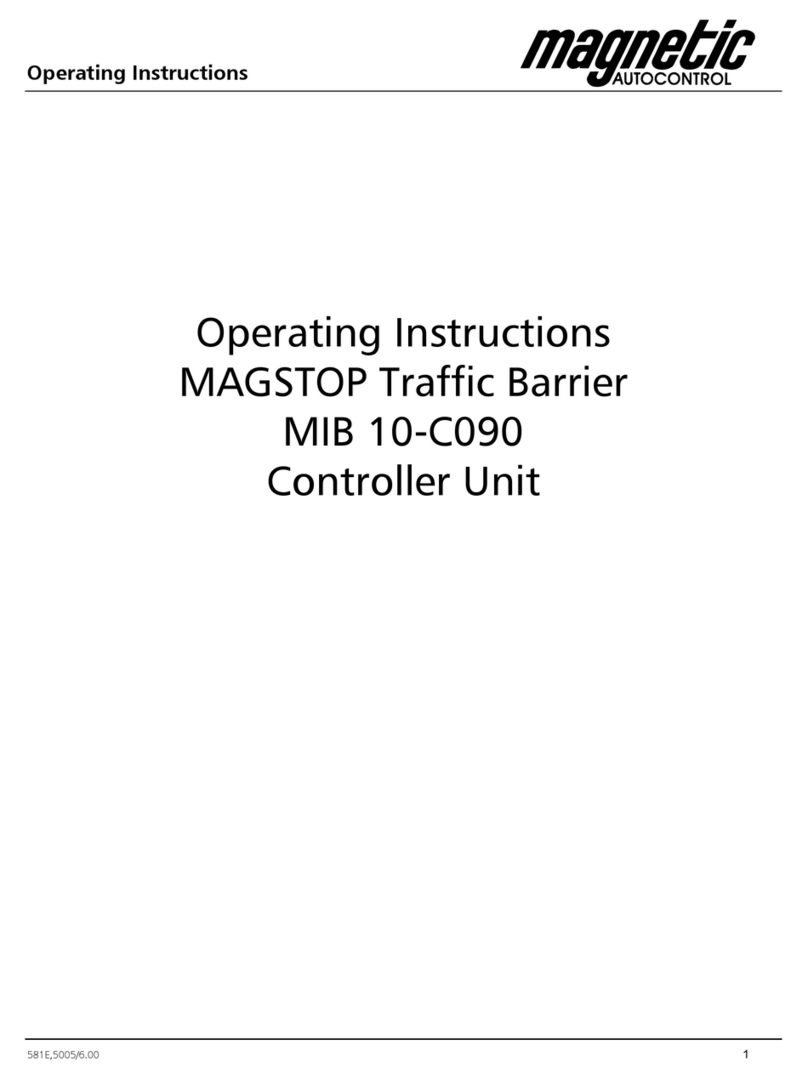
Magnetic Autocontrol
Magnetic Autocontrol MAGSTOP MIB 10-C090 operating instructions
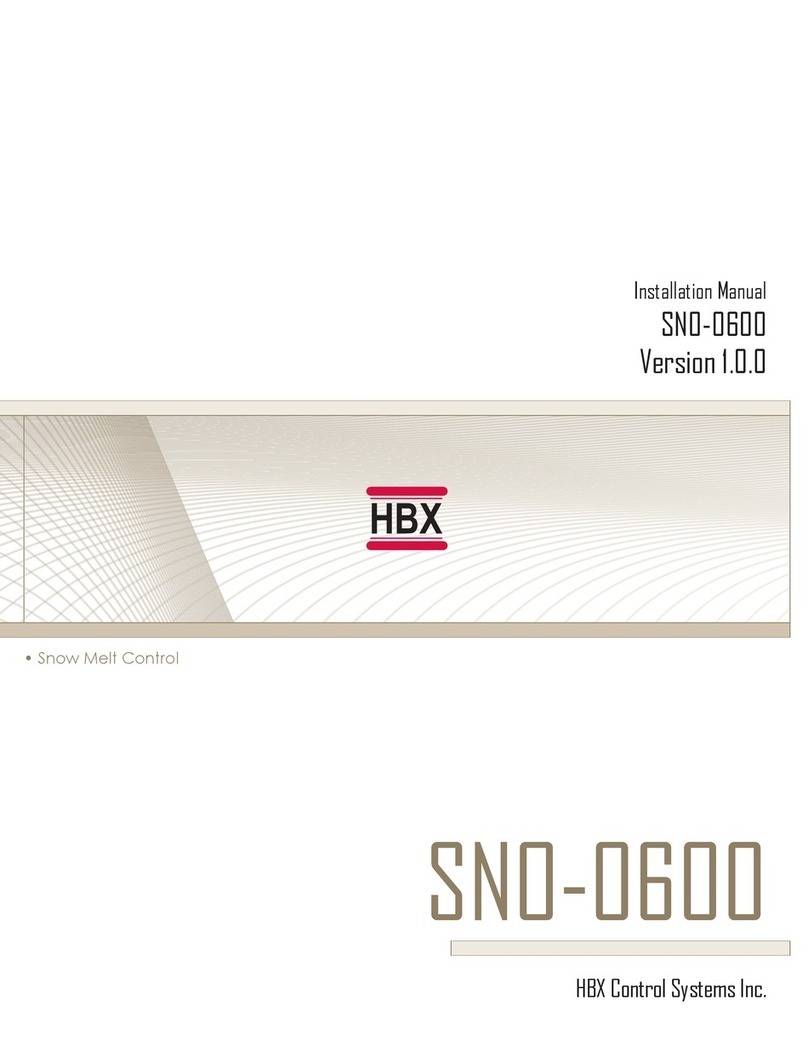
HBX
HBX SNO-0600 installation manual

Penn
Penn P77 Series installation guide

Bosch
Bosch Rexroth NYCe 4000 manual

Linak
Linak JUMBO Home user manual
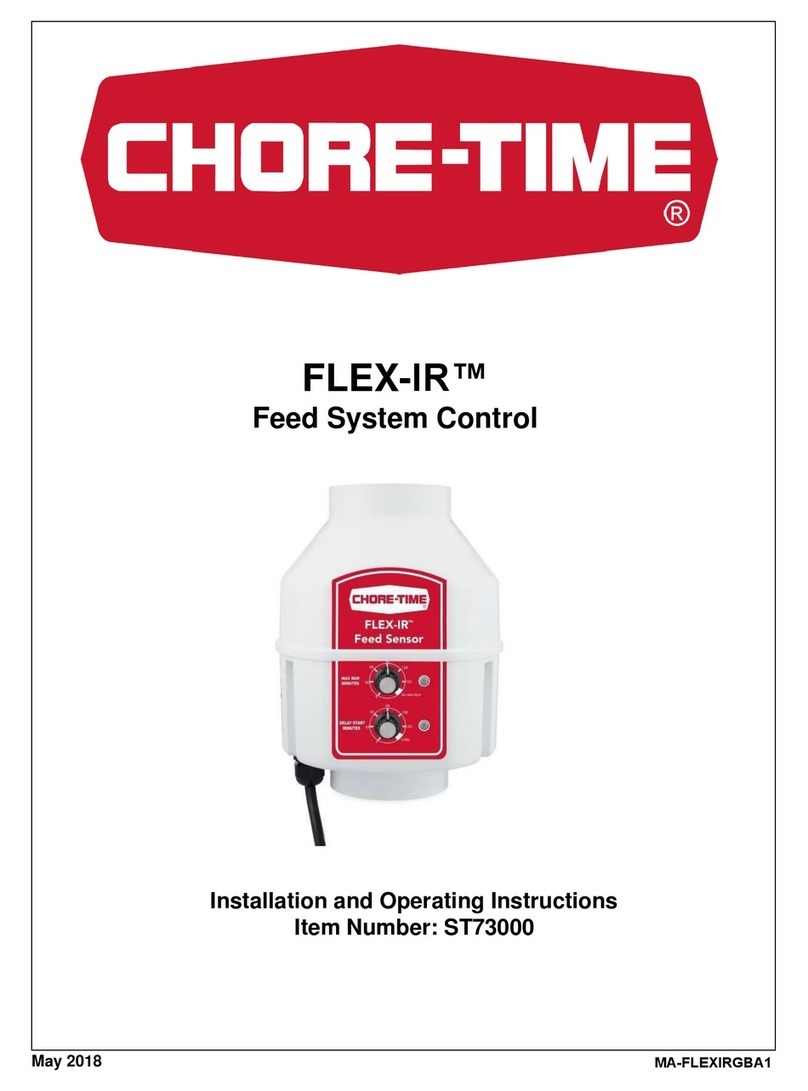
Chore-Time
Chore-Time FLEX-IR ST73000 Installation and operating instructions
